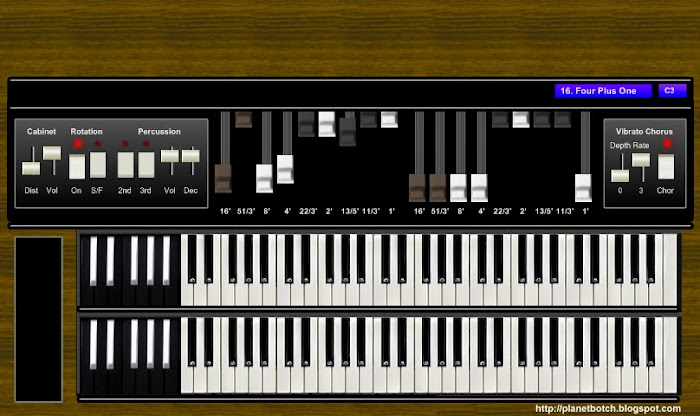
UPDATE: July 2020. The Classic H has now been replaced by The Seductress, as seen above. Don't worry, it's still free, and it's far superior to the Classic H. Visit the Seductress Tonewheel Organ page for your free plugin download.
The Classic H post remains below for reference...

The Classic-H provides the essence of an old tonewheel organ within the VST environment. This VSTi captures the distinctive personality of a classic Hammond/Leslie combination, as well as simulating twin manual operation across a single MIDI keyboard, using a variable key-split function. Thirty extremely cool presets provide a jumping-off point for almost every type of music, from the 'Full Throb' of old time soul to the screaming distortion of Deep Purple-type rock. It does gobble CPU, but it has the sounds, and it doesn't cost a penny.
Each virtual manual has its own set of nine drawbars. The set on the left controls the lower manual. The set on the right controls the upper. You can arrange the drawbars as you please, then split the manuals across the keyboard as you please. By default, all the presets are split at C3. You can change the split point by clicking on the blue selector in the top right hand corner of the console. Because the VSTi uses a separate audio stream for each simulated manual, it will use more resources when both manuals are played simultaneously. To cut down on the amount of resources used, you can set the instrument for single manual operation. This is done by selecting either C1 (upper manual only) or B6 (lower manual only) with the key-split selector.
Next to the key-split selector is the preset selector. Click on this to choose from any of the 30 evocative and highly usable presets. Whether you like vintage soul, gospel, hard rock or jazz, there'll be a great starting point among the presets.
This organ has extensive levels of distortion at its disposal, and will produce anything from subtle vintage roughness, up to roaring rock. Use the Dist fader on the far left of the panel to the left of the drawbars to control the level of distortion. Adjust the Vol control next along the panel to tailor the master volume. The distortion circuit is designed so that cranking up the drive will not change the overall volume as much as a regular distortion. There’s some built-in compensation. But the Vol control will still be of use.
Moving to the right along the same panel, we next reach the rotary speaker switches. The On switch engages the rotation. The S/F defines whether the spin is slow (chorale) or fast (tremolo). The rotary effect simulates a speaker plus horns arrangement and transition from slow to fast or vice versa will encompass two separate rates of rise and fall. All of the features on the Classic-H will record and respond to MIDI control info, so you can record rotary rises and falls into your VST host. However, not all hosts will be able to accurately translate the rises and falls when mixing at high speed. It is recommended that you mix to an audio file in real time in order to exactly preserve the correct characteristics of the rotary rises and falls.
Next along the same panel are the Percussion tabs. The 2nd tab introduces a percussive attack at the pitch of the 4’ drawbar. The 3rd introduces a perc attack pitch matching the 2 2/3’ drawbar. To the right of these tabs are the Vol and Dec faders. Vol controls the volume of the percussive attack, whist Dec controls its length.
On the opposite side of the console, to the right of the drawbars, is the Vibrato Chorus panel. The Chor switch determines whether the effect will produce vibrato or chorus. With the red light on, the effect will produce chorus. However, with the Depth fader set to zero, there will be no effect, regardless of how the Chor switch is set. Increasing the value of the Depth fader increases the depth of the vibrato or chorus. The Rate fader controls the speed of the vibrato or chorus. The higher the value, the faster the rate.
DOWNLOAD & INSTALLATION
The FreeST Classic-H is supplied as a VST plug-in only, and is downloaded as a simple, ready-to-use .dll file. After downloading the .dll file, place it in your VST host’s VstPlugins folder. Most VST hosts will then detect the instrument automatically. If you normally have to add your VSTis manually, please use the same process to add these.
IMPORTANT NOTICE
Before downloading this VST organ, please be aware that it is freeware, created by a hobbyist and not a professional organisation. Every effort has been made to ensure that it works effectively and fulfils its role well. However, it is in no respect guaranteed bug or problem free, and is downloaded and/or used at your own risk. In opting to download or use the FreeST Classic-H you absolve its creator of any responsibilty for any problems you may encounter as a result.
The Classic H has been superseded by the Seductress. Visit The Seductress Download page for your Free tonewheel organ.
Or find More free Virtual Organs via the main landing page.
If you're interested in a very quick crash course on setting Hammond type drawbars for your own sounds, please see& Setting Hammond Drawbars - The Easy Way.

